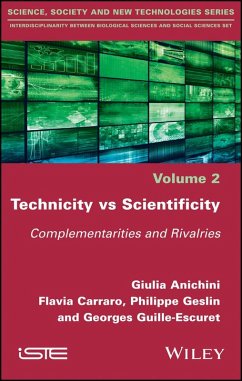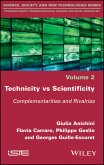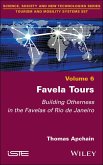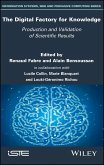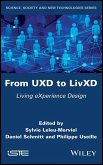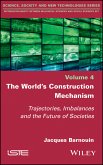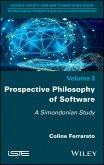Technicity vs Scientificity (eBook, ePUB)
Complementarities and Rivalries


Alle Infos zum eBook verschenken

Technicity vs Scientificity (eBook, ePUB)
Complementarities and Rivalries
- Format: ePub
- Merkliste
- Auf die Merkliste
- Bewerten Bewerten
- Teilen
- Produkt teilen
- Produkterinnerung
- Produkterinnerung

Hier können Sie sich einloggen

Bitte loggen Sie sich zunächst in Ihr Kundenkonto ein oder registrieren Sie sich bei bücher.de, um das eBook-Abo tolino select nutzen zu können.
The relationship between technicity and scientificity is often overlooked or avoided despite being a determining factor for establishing interdisciplinarity. By focusing on this relationship and highlighting a number of its ramifications, this book sheds light on the hidden or skewed stakes that condition a wide array of scientific projects. The authors present different approaches based on their own professional experience, focusing on the technique science relationship in domains as diverse as brain mapping, the decipherment of Mycenaean writing and the design process. Each chapter presents…mehr
- Geräte: eReader
- mit Kopierschutz
- eBook Hilfe
- Größe: 0.88MB
![Technicity vs Scientificity (eBook, PDF) Technicity vs Scientificity (eBook, PDF)]() Giulia AnichiniTechnicity vs Scientificity (eBook, PDF)139,99 €
Giulia AnichiniTechnicity vs Scientificity (eBook, PDF)139,99 €![Favela Tours (eBook, ePUB) Favela Tours (eBook, ePUB)]() Thomas ApchainFavela Tours (eBook, ePUB)114,99 €
Thomas ApchainFavela Tours (eBook, ePUB)114,99 €![The Digital Factory for Knowledge (eBook, ePUB) The Digital Factory for Knowledge (eBook, ePUB)]() The Digital Factory for Knowledge (eBook, ePUB)139,99 €
The Digital Factory for Knowledge (eBook, ePUB)139,99 €![From UXD to LivXD (eBook, ePUB) From UXD to LivXD (eBook, ePUB)]() From UXD to LivXD (eBook, ePUB)139,99 €
From UXD to LivXD (eBook, ePUB)139,99 €![Technogenarians (eBook, ePUB) Technogenarians (eBook, ePUB)]() Technogenarians (eBook, ePUB)21,99 €
Technogenarians (eBook, ePUB)21,99 €![The World's Construction Mechanism (eBook, ePUB) The World's Construction Mechanism (eBook, ePUB)]() Jacques BarnouinThe World's Construction Mechanism (eBook, ePUB)139,99 €
Jacques BarnouinThe World's Construction Mechanism (eBook, ePUB)139,99 €![Prospective Philosophy of Software (eBook, ePUB) Prospective Philosophy of Software (eBook, ePUB)]() Coline FerraratoProspective Philosophy of Software (eBook, ePUB)139,99 €
Coline FerraratoProspective Philosophy of Software (eBook, ePUB)139,99 €-
-
-
Dieser Download kann aus rechtlichen Gründen nur mit Rechnungsadresse in A, B, BG, CY, CZ, D, DK, EW, E, FIN, F, GR, HR, H, IRL, I, LT, L, LR, M, NL, PL, P, R, S, SLO, SK ausgeliefert werden.
- Produktdetails
- Verlag: John Wiley & Sons
- Seitenzahl: 240
- Erscheinungstermin: 29. Juni 2017
- Englisch
- ISBN-13: 9781119406266
- Artikelnr.: 52553917
- Verlag: John Wiley & Sons
- Seitenzahl: 240
- Erscheinungstermin: 29. Juni 2017
- Englisch
- ISBN-13: 9781119406266
- Artikelnr.: 52553917
- Herstellerkennzeichnung Die Herstellerinformationen sind derzeit nicht verfügbar.
Chapter 1 The Artisan, the Sage and the Irony: An Outline of Knowledge
Sociogenesis 1
Georges GUILLE-ESCURET
1.1 Knowledge sociogenesis? Necessary introduction 2
1.1.1 Evolution, history and conjecture: Radcliffe-Brown's block 3
1.1.2 Techniques outside science, science outside techniques 5
1.2 Extra-human or peri-human technicities 8
1.2.1 Involuntary society and impersonal knowledge: termite mound and
workers 8
1.2.2 Techniques and culture in chimpanzees 10
1.3 Junctions, divergences and disparities 11
1.3.1 Putting words to action? 12
1.3.2 Diversity and disparity, conjunction and separation 17
1.4 Forming a triangle: technique, science and ideology 23
1.4.1 Astronomers and architects, priests and administrators 25
1.4.2 Logic and theory without technique: first birth 30
1.4.3 Science thanks to techniques: second birth 34
1.5 The abandoned mystery: "technicity" 38
1.5.1 Immediate markers of technicity 40
1.5.2 Technicity, scientificity and ideology: the distinction of functions
with overlapping roles 44
1.6 Technocracy and scientificity 47
1.6.1 Technocracy: two perspectives in the 1960s 48
1.6.2 Technosciences: the example of molecular biology 51
1.7 The wilting of science, for lack of dissidence 54
Chapter 2 Technicization of the Neurosciences: Uses of Image-Processing
Software in Brain Research 57
Giulia ANICHINI
2.1 Setting the scene Neuroanatomy: from scalpel to screen 59
2.2 The categories challenged by practices 62
2.3 Sulcal morphometry: between automation and scientific expertise 64
2.3.1 Recovery and creation of "raw" data 64
2.3.2 Production of the "mask" 66
2.3.3 Choosing "normal" brain images 68
2.3.4 Labeling the sulci 72
2.4 Comparing brain networks: theory in database exploration 77
2.4.1 Defining the variables and comparing the groups of images 81
2.4.2 Data bricolage 87
2.5 Conclusions 90
Chapter 3 Cryptography, a Human Science? Models, Matrices, Tools and Frames
of Reference 97
Flavia CARRARO
3.1 Decipherment between science and technique, discovery and invention
98
3.1.1 Cryptographies between war and peace 99
3.1.2 An exemplary case: the decipherment of Linear B 103
3.2 The decipherer, the result and the procedure: the impossible solution
and the technical compromise 106
3.3 The Grid, tool, instrument and machine, and the regime of proofs and
tests 112
3.4 An applied and interdisciplinary internal and collective analysis 120
3.5 The patterns and mechanics of the documents 129
3.6 Scribes' hands and autopsy of the tablets 138
3.7 Technomycenology 144
3.7.1 Cuts of pertinence and relays, frames of reference and hierarchies
145
3.7.2 Prince Charming and the scribe of Minos 149
Chapter 4 The Beauty of Equation: The Anthropologist and the Engineer in
Design Processes 155
Philippe GESLIN
4.1 The "beauty of equation" 160
4.2 Eleven outlines for the harmony of the equation 163
4.2.1 First outline: the circulation of technical objects orients future
uses 163
4.2.2 Second outline: circulation can correct the "mistakes" or lack of a
design process 164
4.2.3 Third outline: circulation can encourage certain material, but also
discursive expansions 165
4.2.4 Fourth outline: circulation determines regimes of familiarity and
temporality that summarize technological standardization They can, in
certain cases, contribute to the birth of technoscapes 166
4.2.5 Fifth outline: the experience of techniques is the knowledge that
their deciders, or the public, have, and not necessarily those who directly
use it 168
4.2.6 Sixth outline: in the framework of circulating a technical object, it
is always through the element that constitutes it and that is the most
deterritorialized in relation to the context of receipt that specific forms
of appropriation are noted 169
4.2.7 Seventh outline: the choice of the name given to a technical object
before projects may constrain the design processes and its appropriation
mechanisms 170
4.2.8 Eighth outline: the relationships between things are just as much the
object of experiments as the things themselves 171
4.2.9 Ninth outline: the imitation principle underlies the circulation of
things and their "scale-up" 172
4.2.10 Tenth outline: the proposed solutions are both the process that will
lead to concrete transformations and its most visible results 173
4.2.11 Eleventh outline: the implementation of the sociotechnical points of
reference proposed by the anthropologist and their materialization favor
"acting together" and "testing the sensitive" 175
4.3 The blue note... 176
Conclusion 179
Bibliography 185
Index 203
Chapter 1 The Artisan, the Sage and the Irony: An Outline of Knowledge
Sociogenesis 1
Georges GUILLE-ESCURET
1.1 Knowledge sociogenesis? Necessary introduction 2
1.1.1 Evolution, history and conjecture: Radcliffe-Brown's block 3
1.1.2 Techniques outside science, science outside techniques 5
1.2 Extra-human or peri-human technicities 8
1.2.1 Involuntary society and impersonal knowledge: termite mound and
workers 8
1.2.2 Techniques and culture in chimpanzees 10
1.3 Junctions, divergences and disparities 11
1.3.1 Putting words to action? 12
1.3.2 Diversity and disparity, conjunction and separation 17
1.4 Forming a triangle: technique, science and ideology 23
1.4.1 Astronomers and architects, priests and administrators 25
1.4.2 Logic and theory without technique: first birth 30
1.4.3 Science thanks to techniques: second birth 34
1.5 The abandoned mystery: "technicity" 38
1.5.1 Immediate markers of technicity 40
1.5.2 Technicity, scientificity and ideology: the distinction of functions
with overlapping roles 44
1.6 Technocracy and scientificity 47
1.6.1 Technocracy: two perspectives in the 1960s 48
1.6.2 Technosciences: the example of molecular biology 51
1.7 The wilting of science, for lack of dissidence 54
Chapter 2 Technicization of the Neurosciences: Uses of Image-Processing
Software in Brain Research 57
Giulia ANICHINI
2.1 Setting the scene Neuroanatomy: from scalpel to screen 59
2.2 The categories challenged by practices 62
2.3 Sulcal morphometry: between automation and scientific expertise 64
2.3.1 Recovery and creation of "raw" data 64
2.3.2 Production of the "mask" 66
2.3.3 Choosing "normal" brain images 68
2.3.4 Labeling the sulci 72
2.4 Comparing brain networks: theory in database exploration 77
2.4.1 Defining the variables and comparing the groups of images 81
2.4.2 Data bricolage 87
2.5 Conclusions 90
Chapter 3 Cryptography, a Human Science? Models, Matrices, Tools and Frames
of Reference 97
Flavia CARRARO
3.1 Decipherment between science and technique, discovery and invention
98
3.1.1 Cryptographies between war and peace 99
3.1.2 An exemplary case: the decipherment of Linear B 103
3.2 The decipherer, the result and the procedure: the impossible solution
and the technical compromise 106
3.3 The Grid, tool, instrument and machine, and the regime of proofs and
tests 112
3.4 An applied and interdisciplinary internal and collective analysis 120
3.5 The patterns and mechanics of the documents 129
3.6 Scribes' hands and autopsy of the tablets 138
3.7 Technomycenology 144
3.7.1 Cuts of pertinence and relays, frames of reference and hierarchies
145
3.7.2 Prince Charming and the scribe of Minos 149
Chapter 4 The Beauty of Equation: The Anthropologist and the Engineer in
Design Processes 155
Philippe GESLIN
4.1 The "beauty of equation" 160
4.2 Eleven outlines for the harmony of the equation 163
4.2.1 First outline: the circulation of technical objects orients future
uses 163
4.2.2 Second outline: circulation can correct the "mistakes" or lack of a
design process 164
4.2.3 Third outline: circulation can encourage certain material, but also
discursive expansions 165
4.2.4 Fourth outline: circulation determines regimes of familiarity and
temporality that summarize technological standardization They can, in
certain cases, contribute to the birth of technoscapes 166
4.2.5 Fifth outline: the experience of techniques is the knowledge that
their deciders, or the public, have, and not necessarily those who directly
use it 168
4.2.6 Sixth outline: in the framework of circulating a technical object, it
is always through the element that constitutes it and that is the most
deterritorialized in relation to the context of receipt that specific forms
of appropriation are noted 169
4.2.7 Seventh outline: the choice of the name given to a technical object
before projects may constrain the design processes and its appropriation
mechanisms 170
4.2.8 Eighth outline: the relationships between things are just as much the
object of experiments as the things themselves 171
4.2.9 Ninth outline: the imitation principle underlies the circulation of
things and their "scale-up" 172
4.2.10 Tenth outline: the proposed solutions are both the process that will
lead to concrete transformations and its most visible results 173
4.2.11 Eleventh outline: the implementation of the sociotechnical points of
reference proposed by the anthropologist and their materialization favor
"acting together" and "testing the sensitive" 175
4.3 The blue note... 176
Conclusion 179
Bibliography 185
Index 203
